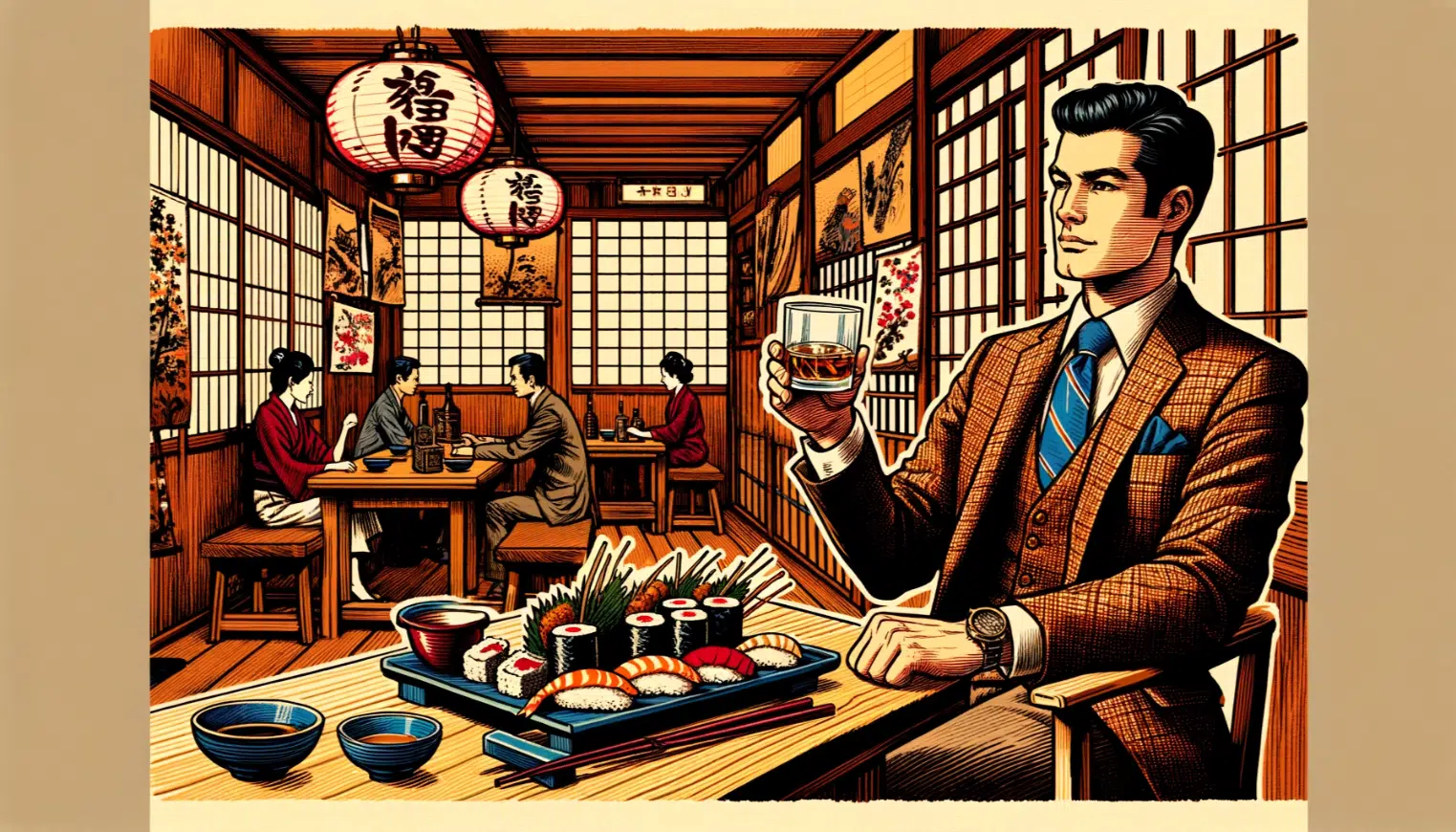Japanese whisky, often regarded as a jewel in the crown of the global whisky scene, shines through with its unparalleled elegance and complexity. This revered spirit distinguishes itself from its Scottish and American relatives by offering a distinct tasting journey that is both subtle and profound. Japanese whisky is celebrated for its meticulous production process, which combines traditional techniques with innovative approaches to flavor and maturation.
What Does Japanese Whisky Taste Like?
Japanese whisky is a testament to the art of whisky-making, offering a unique flavor profile that distinguishes it from its global counterparts. At its core, Japanese whisky is characterized by a delicate balance of fruitiness, oakiness, and maltiness. These primary flavors meld together to create a sophisticated and accessible spirit that appeals to a wide range of palates.
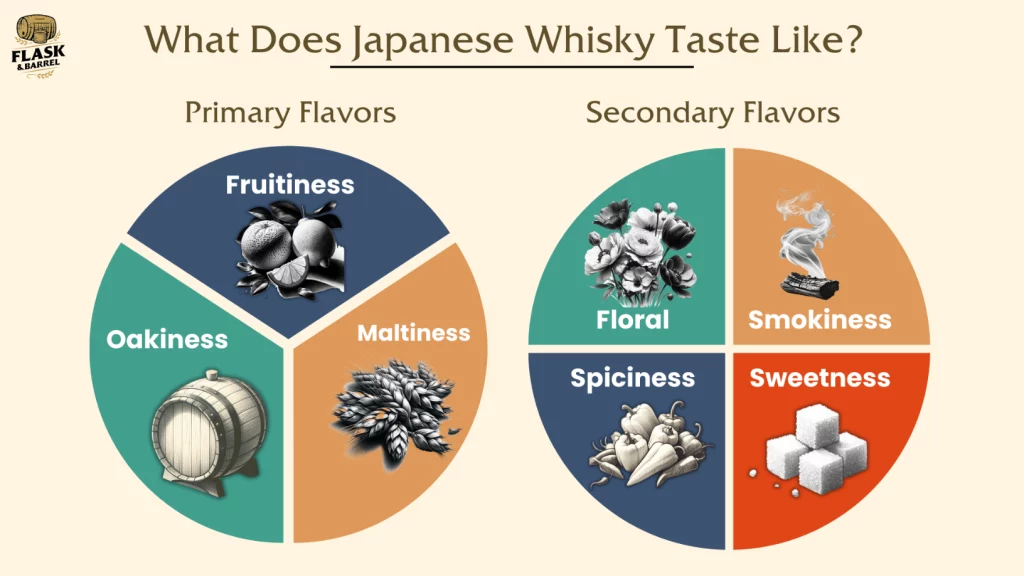
The fruitiness in Japanese whisky often manifests as fresh notes of apple, pear, and citrus, providing a bright and inviting opening. Oakiness, derived from the barrels used in the aging process, introduces hints of vanilla and coconut, adding depth and warmth to the whisky. Maltiness, meanwhile, offers a comforting base of baked goods and rich grains, grounding the spirit in tradition and richness.
Beyond these primary flavors, Japanese whisky is further enhanced by a range of secondary flavors including floral, spiciness, smokiness, and sweetness. These layers of complexity are a testament to the meticulous craftsmanship and innovation that define Japanese whisky-making. Whether it’s the choice of barrels, the specific ingredients, or the precise distillation techniques, each element plays a crucial role in shaping the whisky’s intricate flavor profile.
What truly sets Japanese whisky apart is the meticulous attention to detail and the craftsmanship that is deeply rooted in Japanese culture. From the selection of water and barley to the precision of the distillation process and the careful monitoring of the aging environment, every step is undertaken with the utmost care and precision. This dedication to excellence ensures that each bottle of Japanese whisky is not just a drink, but a celebration of refinement and expression.
In summary, Japanese whisky offers an intricate and inviting tasting experience, marked by a blend of traditional flavors and innovative techniques. It is a spirit that is both smooth and complex, inviting whisky enthusiasts and newcomers alike to explore its rich layers and subtle nuances.
What are the Primary Flavors in Japanese Whisky?
The allure of Japanese whisky lies in its primary flavors: fruitiness, oakiness, and maltiness. These foundational elements craft a tasting experience that is both intricate and harmonious, appealing to a broad spectrum of whisky enthusiasts.
- Fruitiness in Japanese whisky typically unfolds as vibrant notes of apple, pear, and citrus. This layer adds a refreshing and subtly sweet character, inviting the palate to explore further complexities.
- Oakiness emerges from the whisky’s aging process in wooden barrels, imparting rich notes of vanilla and coconut. This dimension contributes warmth and depth, enhancing the overall taste profile.
- Maltiness offers a comforting and earthy base, with flavors reminiscent of baked goods and toasted grains. It anchors the whisky in a tradition of richness and depth.
Together, these primary flavors form the cornerstone of Japanese whisky’s distinctive character. They blend seamlessly to create a spirit that is not only smooth and accessible but also layered with intricate nuances. This balance of flavors reflects the meticulous craftsmanship and innovation that Japanese whisky is renowned for, making it a celebrated choice among spirits worldwide.
Fruitiness
Fruitiness in Japanese whisky introduces a vibrant and refreshing layer, characterized by notes of apple, pear, and citrus. This element adds a subtle sweetness and brightness, making the whisky accessible and inviting. The presence of fruit flavors enhances the overall tasting experience, offering a palate-cleansing effect that paves the way for deeper, more complex flavors.
Oakiness
Oakiness emerges from the whisky’s aging process in wooden barrels, adding rich depth and warmth. With hints of vanilla and coconut, this flavor profile contributes significantly to the whisky’s complexity. The choice of barrels and the aging environment play crucial roles in developing this characteristic, which is essential for the smoothness and rounded quality of the whisky.
Maltiness
Maltiness provides a comforting and earthy foundation to Japanese whisky, marked by flavors of baked goods and toasted grains. This base flavor adds warmth and richness, balancing the lighter fruitiness and oakiness. It reflects the quality of the malt and the precision of the distillation process, ensuring a balanced and nuanced taste profile that is both deep and inviting.
What are the Secondary Flavors in Japanese Whisky?
Japanese whisky’s allure is further enhanced by its secondary flavors, which introduce additional layers of complexity and intrigue. These flavors, including floral, spiciness, smokiness, and sweetness, contribute significantly to the spirit’s distinctive character.
- Floral notes bring a light, aromatic quality to the whisky, offering subtle hints of blossoms and fresh gardens. This delicate aspect adds a layer of sophistication and depth, appealing to those who appreciate nuanced aromatics in their spirits.
- Spiciness delivers a vibrant, energetic kick, introducing flavors like pepper, cinnamon, and other spices. This dimension enhances the whisky’s complexity, providing a warm and engaging tasting experience.
- Smokiness is a rich, earthy undertone that adds depth and intensity. Derived from the malting process, where peat may be used, smokiness infuses the whisky with a sense of tradition and a connection to the natural elements used in its production.
- Sweetness rounds out the flavor profile, offering a counterbalance to the more robust elements. It can manifest as notes of honey, caramel, or toffee, providing a smooth, pleasing finish that lingers on the palate.
Together, these secondary flavors weave a rich tapestry of taste, making Japanese whisky not just a beverage, but a captivating experience for the senses.
Floral
Floral accents in Japanese whisky bring an aromatic elegance to the spirit. These notes, evoking the subtle fragrance of blossoms and fresh gardens, add a light and sophisticated layer. This dimension offers a nuanced complexity that is both inviting and refreshing.
Spiciness
Spiciness in Japanese whisky introduces a dynamic warmth to the palate. With hints of pepper, cinnamon, and nutmeg, it injects an energetic vibrancy, deepening the whisky’s flavor profile and inviting a more engaged tasting experience.
Smokiness
Smokiness adds a rich, earthy undertone to Japanese whisky, often stemming from the use of peat during the malting process. This characteristic infuses the spirit with a profound depth and intensity, connecting it to traditional whisky-making practices and the natural elements.
Sweetness
Sweetness provides a smooth and harmonious balance to the robust flavors of Japanese whisky. Manifesting as honey, caramel, and toffee notes, this aspect delivers a pleasing and smooth finish, beautifully rounding out the spirit’s complex taste profile.
What Gives Japanese Whisky its Flavor?
The distinctive flavor of Japanese whisky is a testament to a symphony of factors that work in harmony to create its unique taste. Central to this are the quality of ingredients, the precision of the distillation process, and the characteristics of the aging environment.
- Water quality is fundamental, with many distilleries sourcing from pristine natural reserves. This element provides a pure and clear foundation for the whisky, influencing its overall smoothness and clarity.
- The selection of barley and the use of specific yeast strains are crucial in developing the whisky’s underlying character and aromatic profile. These ingredients are carefully chosen to ensure a rich and complex flavor base.
- Distillation techniques, refined over generations, are key to achieving a smooth and refined texture. Japanese whisky makers employ both traditional and innovative methods to distill their spirits, ensuring a product of the highest quality.
- The choice of casks for aging is another vital component. Whether using American oak, sherry casks, or Japanese Mizunara oak, each type of wood imparts different flavors, ranging from vanilla and coconut to subtle fruit and spice notes.
- Lastly, the climate of Japan, with its distinct seasons and varying humidity levels, plays a significant role in the maturation process. The changing temperatures facilitate a dynamic aging process, contributing to the whisky’s complex flavor profile.
Together, these elements craft the rich, nuanced, and highly sought-after taste of Japanese whisky, making it a celebrated spirit on the global stage.
How Does Aging, Distilling, and Mashing Impact the Flavor of Japanese Whisky?
The flavor profile of Japanese whisky is significantly shaped by three key processes: aging, distilling, and mashing. Each of these stages contributes distinct characteristics and complexities to the final product.
- Aging plays a crucial role in flavor development. As whisky matures in wooden casks, it absorbs a variety of flavors ranging from vanilla and caramel to fruit and oak. The aging process also softens the whisky, enhancing its complexity and depth. The specific conditions of aging, particularly in Japan’s unique climate, further influence the whisky’s character and taste.
- Distilling is pivotal in determining the whisky’s purity and texture. Through careful control over distillation temperatures and the choice between pot stills or continuous stills, distillers can significantly alter the whisky’s flavor profile. This stage is essential for achieving the desired smoothness and clarity in the spirit.
- Mashing sets the foundational taste of the whisky. This process involves converting the starches in grains into fermentable sugars, which then influence the whisky’s sweetness, body, and overall flavor. The selection of grains, the composition of the mash bill, and the quality of water used are all critical factors that impact the final taste.
Together, aging, distilling, and mashing intertwine to craft the distinctive and cherished taste of Japanese whisky, showcasing the meticulous craftsmanship and tradition that define this celebrated spirit.
How Does Proof Affect Japanese Whisky’s Flavor?
The proof of Japanese whisky, indicative of its alcohol content, significantly influences its flavor dynamics. High proof whiskies bring a more intense and concentrated flavor experience, with pronounced character and depth. This heightened alcohol level tends to amplify both primary and secondary flavors, making them more striking to the palate.
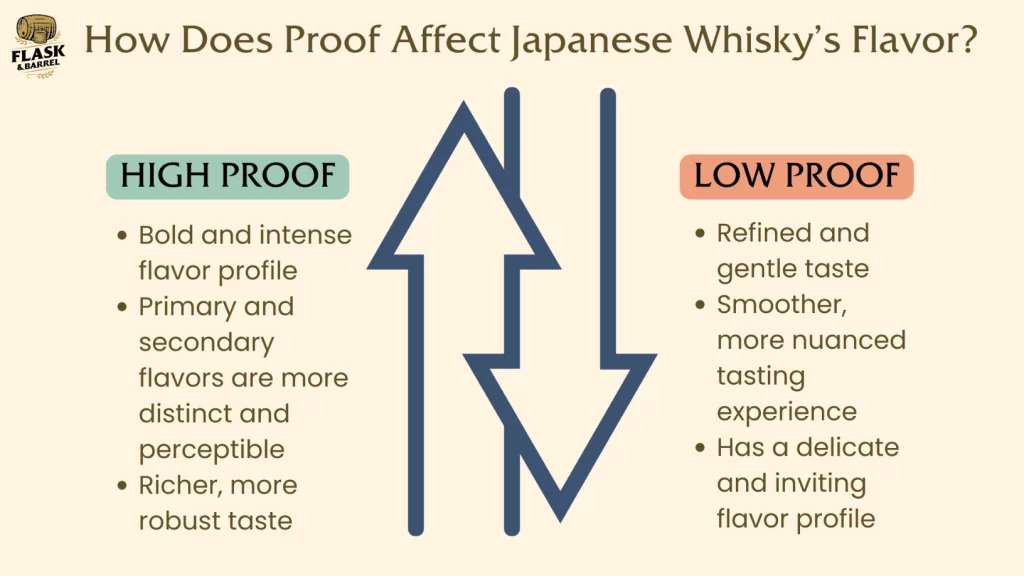
Conversely, low proof whiskies are characterized by their smoothness and mellowness, allowing for a subtler, more nuanced expression of flavors. The lower alcohol content can make these whiskies more approachable, especially highlighting delicate nuances that might be overshadowed at higher proofs. Therefore, the choice of proof is a critical factor in the production of Japanese whisky, as it directly impacts the balance between intensity and smoothness, shaping the overall tasting experience.
High Proof
High Proof Japanese whisky delivers a bold and intense flavor profile. The elevated alcohol content accentuates the spirit’s inherent characteristics, making both primary and secondary flavors more distinct and perceptible. This heightened intensity can enhance the overall sensory experience, revealing deeper layers of complexity and richness that are particularly appealing to those who seek a robust tasting journey.
Low Proof
In contrast, Low Proof Japanese whisky is celebrated for its refinement and gentleness. With lower alcohol levels, these whiskies provide a smoother, more nuanced tasting experience. The subtlety of flavors is more pronounced, allowing for a sophisticated exploration of the whisky’s aromatic and taste nuances.
This approachability and balance make low proof whiskies an excellent choice for both novices and connoisseurs seeking a delicate and inviting flavor profile.
What Food Tastes Good with Japanese Whisky?
Pairing Japanese whisky with the right food can significantly enhance the tasting experience, allowing the spirit’s nuanced flavors to shine alongside complementary dishes.
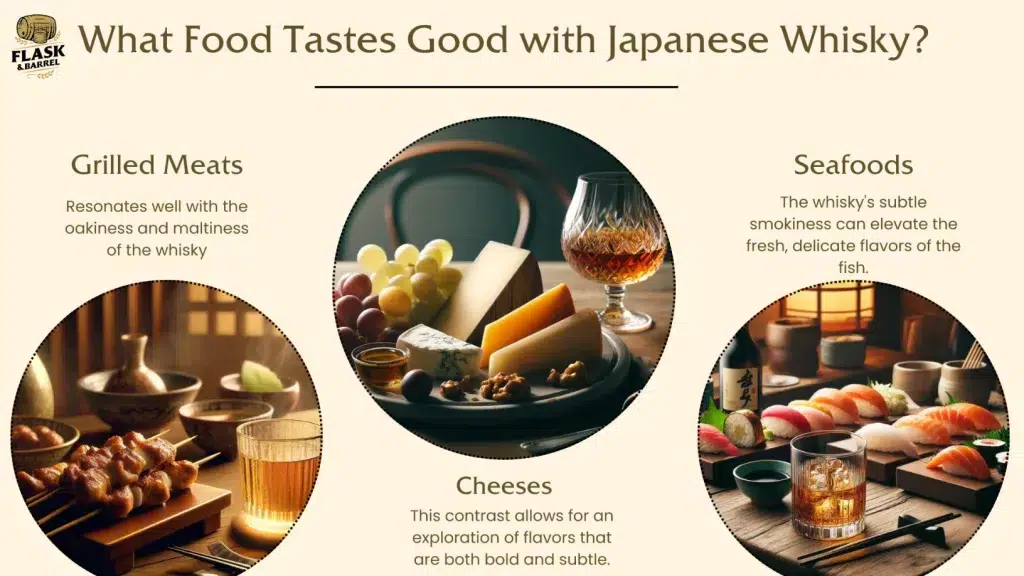
- Seafood, especially sushi and sashimi, pairs wonderfully with Japanese whisky. The whiskey’s subtle smokiness can elevate the fresh, delicate flavors of the fish, creating a harmonious balance between the two.
- Grilled meats, such as yakitori or a lightly seasoned steak, resonate well with the oakiness and maltiness of the whisky. This pairing brings forth a rich and satisfying culinary experience, highlighting the depth of both the food and the spirit.
- Cheese offers a versatile pairing option. Softer cheeses can accentuate the whisky’s fruitiness, while aged varieties can complement its deeper, woody notes. This contrast allows for an exploration of flavors that are both bold and subtle.
- For dessert, dark chocolate serves as an excellent companion to Japanese whisky. The chocolate’s bitterness and richness can underscore the whisky’s sweetness and complexity, providing a delightful finish to the meal.
These pairings not only complement the distinct flavors of Japanese whisky but also offer a glimpse into Japan’s rich culinary culture, making each sip and bite a unique exploration of taste and tradition.
Does Japanese Whisky Taste Stronger than Other Alcohol?
The question of whether Japanese whisky tastes stronger than other types of alcohol hinges on its unique flavor profile and alcohol content. Japanese whisky’s distinct blend of fruitiness, oakiness, and maltiness may influence perceptions of its strength. The careful distillation and aging processes it undergoes contribute to a smoothness that can sometimes mask the sensation of alcohol strength, potentially making it feel milder on the palate compared to its actual ABV (Alcohol by Volume).
Moreover, the complexity of secondary flavors, such as smokiness and spiciness, can add a perception of depth and intensity that is not directly related to the alcohol content. As a result, the perception of strength in Japanese whisky versus other alcohols is not merely a matter of ABV but also a reflection of the intricate balance and character of the whisky itself. This makes the experience of tasting Japanese whisky uniquely engaging, with its perceived strength being just one element in a rich tapestry of flavors.
Does Japanese Whisky Lose its Taste Over Time?
Japanese whisky, much like other spirits, it may undergo changes in its taste profile over time, but these alterations hinge on the conditions under which the whisky is stored. Once bottled, Japanese whisky remains relatively stable due to its high alcohol content, which serves as a natural preservative. Nonetheless, factors such as exposure to light, temperature fluctuations, and air can gradually influence the whisky’s flavor nuances.
A sealed bottle of Japanese whisky minimizes oxidation, helping to preserve its original flavors and aromas. In contrast, an open bottle becomes more prone to taste changes; as the level of whisky drops and air occupies more space within the bottle, the process of oxidation can subtly alter the spirit’s character. To maintain the quality and taste of Japanese whisky over time, proper storage is key.
Keeping the whisky away from direct sunlight and in an environment with consistent temperature can significantly help in preserving its distinctive taste and aroma, ensuring that the whisky can be enjoyed as intended, even years after opening.
Does The Best Japanese Whisky Have To Be Expensive?
The question of whether the best japanese whisky is also the most expensive is nuanced, as the correlation between price and taste is not always direct. Expensive whiskies often denote the use of rare ingredients, prolonged aging, and meticulous production methods, all of which contribute to a distinctive and complex flavor profile that enthusiasts may highly value. However, taste is subjective, and a higher price tag does not universally guarantee a superior tasting experience for every individual.
Many affordable Japanese whiskies demonstrate exceptional quality and can provide tasting experiences that rival, or even exceed, those of their more expensive counterparts. The true enjoyment of Japanese whisky thus boils down to personal preference, with both high-end and budget-friendly options capable of offering satisfaction and delight to the palate.
How Does The Taste of Japanese Whisky Compare to Other Spirits?
Japanese whisky stands out in the spirits world with its unique flavor profile, marked by a harmonious blend of fruitiness, oakiness, and maltiness. Compared to American whiskey, which often features a sweeter, more pronounced profile due to its corn-based mash bills, Japanese whisky is celebrated for its subtlety and refined taste, emphasizing balance and smoothness. Against Scotch whisky, Japanese whisky typically presents a lighter, more delicate flavor palette, steering clear of the heavy peatiness found in some Scotch varieties to favor a nuanced approach to smokiness.
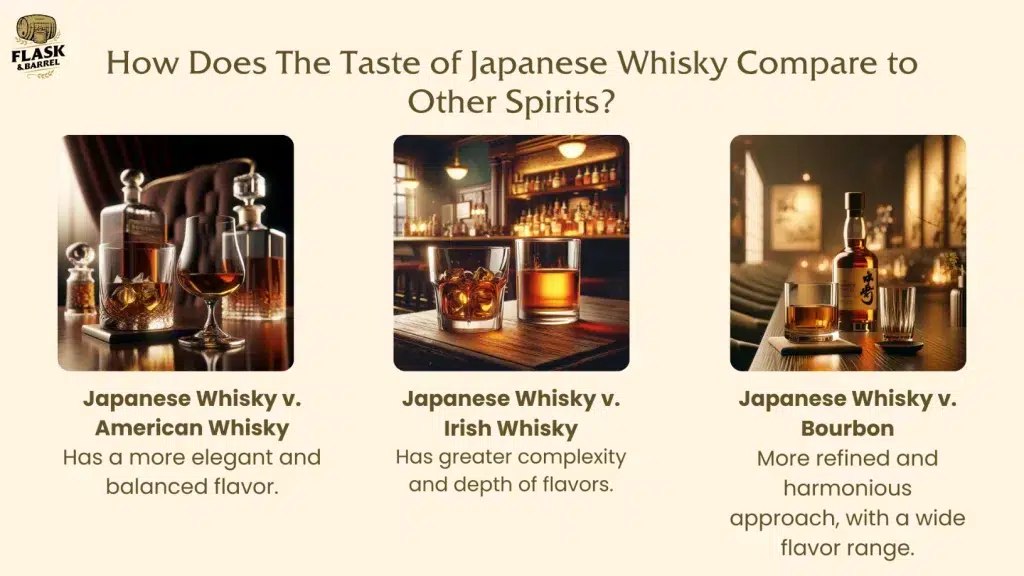
In contrast with Irish whiskey, renowned for its smooth and accessible character, Japanese whisky introduces a higher level of complexity and depth, often showcasing a wider array of secondary flavors such as floral notes, spiciness, and sweetness. This distinct taste of Japanese whisky, crafted through meticulous attention to detail and a blend of traditional and innovative techniques, positions it as a unique offering within the spirits landscape. It appeals to a broad spectrum of whisky enthusiasts and connoisseurs, distinguishing itself as a versatile and complex spirit.
The Taste of Japanese Whisky vs. American Whisky
Japanese whisky is celebrated for its elegance and balance, showcasing a spectrum of subtle fruitiness, oakiness, and maltiness. This contrasts with American whisky, which is typically richer and sweeter, characterized by strong vanilla and caramel flavors, a result of the corn-based mash and aging in new charred oak barrels.
The Taste of Japanese Whisky vs. Irish Whisky
Against Irish whisky, known for its smooth and light character, Japanese whisky introduces a greater complexity and depth of flavors. While Irish whisky often features a creamy texture with fruit and nut undertones, Japanese whisky expands the palette with subtle smokiness, spiciness, and a pronounced influence from its diverse cask usage, offering a more layered and intricate tasting experience.
The Taste of Japanese Whisky vs. Bourbon
Comparing Japanese whisky to bourbon, the latter stands out for its bold sweetness and robust flavors of corn, vanilla, and oak, driven by specific production requirements and the use of new charred oak barrels. Japanese whisky, on the other hand, opts for a more refined and harmonious approach, with a wide flavor range that can include floral, fruity, spicy, and woody notes. This distinction highlights the nuanced and subtle craftsmanship behind Japanese whisky, setting it apart from bourbon’s more direct and assertive taste profile.
How To Drink Japanese Whisky?
Maximizing the taste of Japanese Whisky involves embracing practices that enhance its distinctive flavors and aromas. Knowing how to drink Japanese whisky and utilizing proper glassware, such as a tulip-shaped nosing glass, is crucial for concentrating the whisky’s aromas and flavors, making them more pronounced and enjoyable. Serving the whisky at a slightly chilled temperature can also refine its taste profile, though preferences vary—whether enjoyed neat, with a splash of water, or on the rocks.

Adding a bit of water to the whisky can open up its complex flavors, making the experience smoother by reducing the intensity of the alcohol. Pairing whisky with food that complements its unique flavors, such as seafood or dark chocolate, can further elevate the tasting experience. To ensure the palate is receptive to the whisky’s subtleties, avoid strong flavors before tasting.
By following these practices and approaching tasting with a mindful and unhurried attitude, enthusiasts can fully appreciate the depth and complexity of Japanese whisky, unlocking a truly enriched sensory journey.

